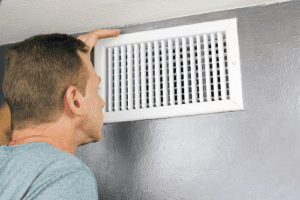The good news is that carbon monoxide HVAC problems aren’t necessarily typical. Today’s HVAC units will typically have been so well-tested and carefully rated that you can rely on them to distribute only hot or cold air—not dangerous fumes. However, as your system gets older, it is important to be vigilant about maintaining it carefully and making sure that it is still safe to operate in your home. Carbon monoxide poisoning is a major health hazard and is something you need to take seriously to ensure the wellbeing of your family and yourself.
What Is Carbon Monoxide Poisoning?
 Carbon monoxide is a colorless, flavorless, odorless gas that is produced through the burning of fuel. It causes a set of symptoms known collectively as “carbon monoxide poisoning,” and can be lethal in high concentrations. One of the biggest challenges of carbon monoxide exposure is that carbon monoxide has many of the same symptoms as the flu, including dizziness, headache, fatigue, light-headedness, and nausea. According to the CDC, 400 people die each year from carbon monoxide poisoning, while an additional 20,000 visit the emergency room for treatment and 4,000 are hospitalized for severe symptoms.
Carbon monoxide is a colorless, flavorless, odorless gas that is produced through the burning of fuel. It causes a set of symptoms known collectively as “carbon monoxide poisoning,” and can be lethal in high concentrations. One of the biggest challenges of carbon monoxide exposure is that carbon monoxide has many of the same symptoms as the flu, including dizziness, headache, fatigue, light-headedness, and nausea. According to the CDC, 400 people die each year from carbon monoxide poisoning, while an additional 20,000 visit the emergency room for treatment and 4,000 are hospitalized for severe symptoms.
Carbon Monoxide, HVAC, and What You Need to Know
Technically, carbon monoxide HVAC problems are a risk with any appliance that burns fuel inside your home. In particular, gas-powered furnaces, wood-burning stoves, fireplaces, or any other appliances that burn gas, propane, oil, wood, or other types of fuel all produce carbon monoxide. These systems are designed to protect your home and everyone inside of it safe from exposure. However, here are a few ways in which your HVAC system might distribute carbon monoxide throughout the house.
- Your furnace has a cracked heat exchanger: The job of a furnace’s heat exchanger is to keep the combustion/fuel-burning portion of your furnace separate from the air that flows throughout your home. Said another way, when your furnace kicks on, the flames inside it are not directly heating the air. Instead, the furnace burns fuel and the flames from that process warm the heat exchanger, which then plays the role of warming up the air. A fan then distributes the air throughout the ducts in your house. If there is a crack in the heat exchanger, then these two processes are no longer fully separated, which can allow carbon monoxide to leak into the heated air and spread throughout the home.
- Clogged furnace filters: Furnace heat exchangers don’t crack for no reason. In most cases, this type of damage occurs because the exchanger has been strained or overstressed in some way. Clogged furnace air filters are one cause of this particular problem. If the filter is clogged, it can impact airflow into and out of the furnace. This impeded airflow causes the furnace to work that much harder to achieve thermostat temperature throughout the home. The heat exchanger, in particular, will strain and overheat, causing it to expand and contract more rapidly or excessively than it usually would. While the heat exchanger is designed for some level of expansion and contraction, too much can cause small cracks to form, allowing carbon monoxide to leak into the house.
- Poor furnace sizing. Similar to clogged furnace filters, an improperly-sized furnace will work harder than it was ever designed to work. The strain exists whether the furnace is undersized or oversized. In the former case, the furnace will run overtime trying to reach the thermostat temperature for the home, leading to an overheated and overstressed exchanger. In the latter case, the furnace will push out so much warm air that it creates patches of hot and cold throughout the house. This inconsistency in temperature makes it difficult for the furnace ever to satisfy the thermostat setting, leading it to switch on and off much more often than an accurately-sized furnace would do. This up-down cycle of activity puts extra strain on the heat exchanger, reducing the furnace’s lifespan at best and risking cracks and carbon monoxide problems at worst.
- Improper venting. All appliances that burn gas (or any other fuel) need to be vented carefully and correctly. The carbon monoxide produced in the combustion process needs somewhere to go, which means there should be a vent system that carries the gas directly out of the appliance and out of the house. If the joints or pipes on the ventilation design are damaged or fitted improperly, that can lead to leaks that risk carbon monoxide poisoning.
- Your HVAC equipment has not been serviced or repaired: How long has it been since you contacted your HVAC technician for an HVAC service call? Having your appliances inspected and maintained annually will help you spot leaks or other signs of damage that might lead to carbon monoxide problems. Don’t just focus on the furnace, either. Other heating equipment—such as space heaters, heat pumps, or water heaters—can also be liabilities if you defer maintenance.
As you plan a strategy for minimizing carbon monoxide HVAC risk, also remember that carbon monoxide can come from other areas in your home as well. Have your gas stove serviced regularly to look out for potential risks there. If you have a fireplace or wood-burning stove, make sure you have the equipment and chimneys/flues cleaned regularly to ensure proper airflow and ventilation. Finally, install a carbon monoxide detector to make sure you’ll know early on if there is a problem in your home.

